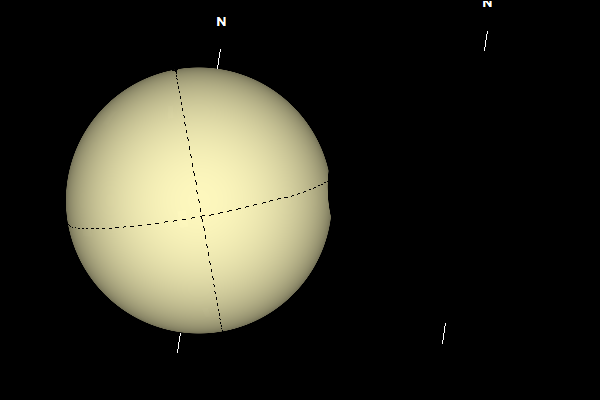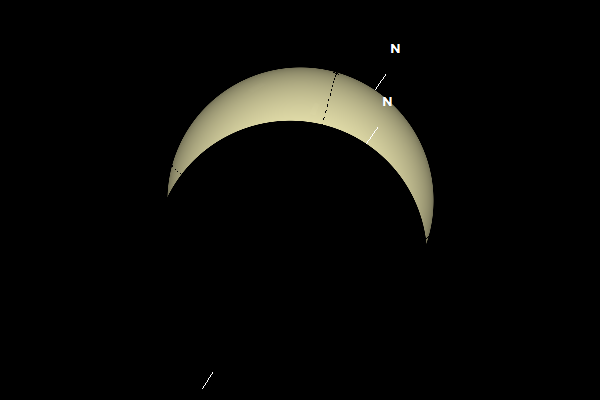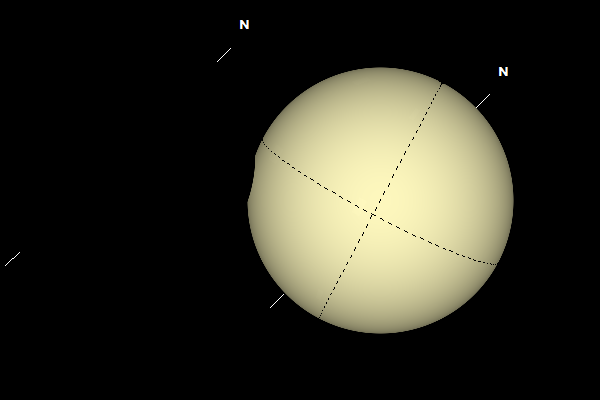
Solar Eclipse of August 21, 2017
Sun in Partial Eclipse at this Location
Cinnaminson, NJ (Philadelphia, PA, area)
40.000°N, 75.000°W
The circumstances of the eclipse for this location are tabulated below (ΔT = 69.4 seconds).
|
Event |
EDT |
Sun's Altitude |
Sun's Azimuth | Position Angle |
Vertex Angle |
|
Eclipse Begins |
1:21:33.4 pm | 61.6° | 189.6° | 281.3° |
273.9° |
|
Maximum Eclipse |
2:44:28.6 pm | 54.0° | 225.6° | –– |
–– |
|
Eclipse Ends |
4:01:20.3 pm | 41.7° | 247.1° | 126.1° |
80.1° |
Duration: 2 hr 39 min 47.0
sec
Magnitude: 0.797
Obscuration: 75.0%
New Moon: 2:30 pm EDT
The data above was generated with the U.S. Naval Observatory's MICA Version 2.2.2 software, but it's also available from the USNO online. For other locations, click here. There's additional eclipse information on that page too.
Note: Position Angle refers to the point where the lunar limb contacts the solar limb, measured from the point on the sun's limb towards the north celestial pole (zero degrees) then circling eastward (counterclockwise) around the solar disc. Vertex Angle is similar, except that it's measured from the point on the sun's limb towards the zenith. Magnitude refers to the linear span which the moon's disc extends across the sun. Obscuration refers to the area of the sun covered by the moon.
For an idea of where to look for the moon on the solar disc in the Philadelphia area (nominally 40°N-75°W), the diagrams below show a zenith-up view of the sun at several points during the eclipse: (1) 1:22 pm, just after the lunar silhouette (moving west to east, or right to left) makes first contact with the western limb of the sun, (2) 2:44 pm, at maximum eclipse, and (3) 4:00 pm, just before last contact of the moon's silhoutte as it moves off the solar disc. These views were generated with WinJUPOS Version 10.3.5. The ≈vertical dashed line on the solar disc represents the sun's central meridian and the ≈horizontal dashed line represents the sun's equator.
Note: The images below simulate views through binoculars equipped with proper solar filtration -- the images are correct vertically and horizontally, and the horizontal edges of the frames are parallel to the horizon. To prevent severely damaged vision, never look at the sun, even during partial eclipse, without an appropriate solar filter, whether one is using a telescope, binoculars or unaided eyes!

1:22 pm EDT, just after first contact when the lunar silhouette moves onto the western limb of the solar disc.

2:44 pm EDT, maximum eclipse with 75% of the solar disc obscured by the moon.

4:00 pm EDT, just before last contact when the lunar silhouette moves off the eastern limb of the solar disc.
Here's a link to the Fred Espenak/NASA information page about this eclipse.
Last Update:
Tuesday, October 10, 2017
at 02:49 PM Eastern
Time
by Joe Stieber at
SJAstro.org